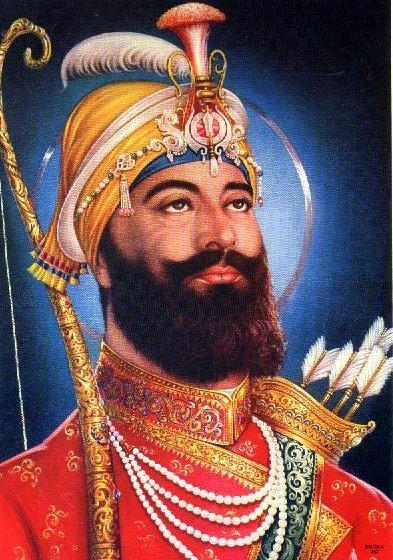 Guru Gobind Singh : Founder of the Khalsa Guru Gobind Singh : Founder of the Khalsa
|
Index
- Introduction
- Guru Gobind Singh’s birth
- Guru Gobind Singh, Tenth Guru of Sikhs sacrificed his entire family on fighting to death with Mughals for protecting Dharma !
- Creation of the Khalsa by Guru Gobind Singh
- The Panj Pyare (The five beloved ones)
- Guru Gobind Singh’s Bani
Introduction of Guru Gobind Singh
Guru Gobind Singh’s birth
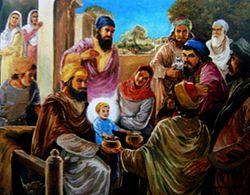 Birth of Guru Gobind Singh Birth of Guru Gobind Singh
|
Guru Gobind Singh was born as Gobind Rai in Patna to Guru Tegh Bahadur and his wife Mata Gujari. He was born while Guru Tegh Bahadur was touring Assam to spread his teachings.
It was here that Gobind Rai was born to Mata Gujari 1666. It is said that Pir Bhikan Shah approached the child and offered two bowls of milk and water, signifying both the great religions of Hinduism and Islam. The child smiled and placed his hands on both bowls. The Pir bowed in utter humility and reverence to the new Prophet of all humanity.
Guru Gobind Singh was born with a holy mission of which he tells us in his autobiography “Bachitar Natak” (Wonderous Drama). Guru Ji describes the purpose of his coming to this world and why he emerged from the Supreme Reality in human form to carry out his Creator’s command:
“For this purpose was I born, let all virtuous people understand. I was born to advance righteousness, to emancipate the good, and to destroy all evil-doers root and branch.”
Guru Gobind Singh, Tenth Guru of Sikhs sacrificed his entire family on fighting to death with Mughals for protecting Dharma !
Punjab state is endowed with a unique history from Vedic era to Mahabharat period. Mughals Sultans had totally crushed Punjab state by onslaughts which lasted for about 400 years. To save Punjab from this onslaught, Sikh sect came into existence due to foresight of Guru Nanak. To counter this unjust attack, ten Gurus of Sikhs fought fiercely against the invaders. Guru Gobind Singh is tenth and last Guru of Sikh sect. His birth anniversary falls on January 5. On this occasion, the saga of His fight against Mughals is narrated ahead, Our humble obeisance to Guru Gobind Singh on His birth anniversary !
Guru Gobind Singh assassinating Paindekhan, a knight sent by Aurangjeb to Alamapur, by putting an arrow through his temple, Aurangjeb cutting off food supply to Alamapur and Sikhs fiercely resisting even this calamity
When Guru Gobind Singh was stationed at Alamapur, Aurangjeb sent two of his knights, Paindekhan and Dinabeg, there with an army. Their policy was to avoid the battle in proper Alamapur as far as possible. All the Sikhs accosted Paindekhan on the way and started fighting with him with a vengeance. Guru Gobind Singh killed Paindekhan by shooting an arrow through his temple. Similarly, injured Dinabeg had to run away. As a last resort, Aurangjeb cut off the food supply to Alamapur from the Kings of Bhuta, Kulu, Kainthal, Chamba, Dadwal, and Shrinagar, but Sikhs fiercely resisted even this calamity. At last, this cold war ended with the meditation of King of Basali.
Aurangjeb dispatching a large army under the leadership of Vajir Khan to Anandpur, many Sikhs getting killed in the war, and Sikhs had to beat a retreat against the might of Mughal army
When Aurangjeb realised that Guru of Sikhs would not surrender, he dispatched a large army under the leadership of Vajir Khan to Anandpur. While fighting with him, many Sikhs got killed in the war. Sikhs also killed many Muslim soldiers. On that occasion, Sikhs had to beat a retreat against the might of Mughal army.
Guru Gobind Singh and His family members were compelled to starve due to food stocks getting exhausted, Vajirkhan promising impunity to everyone in Anandpur on the orders of Aurangjeb, and Guru Gobind Singh escaping from siege laid by Mughals
Due to strict siege laid around Anandpur, the stock of food stored there started getting exhausted. Due to starvation, some good horses and a famous elephant, ‘Prasadi’ also died. Guru Gobind Singh and His family members were also compelled to endure starvation, but he was not ready to leave Anandpur. At last, Vajirkhan promised impunity to everyone in Anandpur on the orders of Aurangjeb. Guru Gobind Singh was aware that the promise made by Mughals was never kept. At last, He escaped the siege with His family members in the night of December 6, 1705. Before leaving, He destroyed as many goods as possible.
Mughal army chasing Guru Gobind Singh and laying a siege to the fort, Guru Gobind Singh and His family members were unarmed, two of His sons getting martyred in an effort to break the siege, and Guru Gobind Singh was left alone on getting separated from His colleagues
Mughal army chased Guru Gobind Singh, and first skirmish took place on the bank of river ‘Shirasa’. Famous knight Bhai Udaysingh was killed in the skirmish. On crossing the river ‘Shirasa’, Guru Gobind Singh reached Chhamkaur and took shelter along with His family members in the fort there. Mughal army also chased Him and laid siege to this fort. The situation became very serious. Guru Gobind Singh and His family members were unarmed. Similarly, there was an acute shortage of food items. His two elder sons, Ajit Singh and Zujar Singh were martyred in an effort to break the siege. Guru Gobind Singh escaped along with His 3 trusted Sikh colleagues, Bhai Dayasing, Dharamsing, and Mansing. At the end, Guru Gobind Singh also got separated from these 3 Sikhs and was left alone. He had no army, body-guards, wealth, and friends with Him, but he did not desert His pride. He was held up in the forest of ‘Machhivara’. His clothes were torn, He had no footwear. He used to sleep with a flat stone as a pillow.
Nawab of Sirhand seized the wife and two sons of Guru Gobind Singh and gave them option either to get killed or converted; on refusing to get converted, Nawab killing the sons by entombing them live in the wall
Nawab of Sirhand took the wife Mata Sahib Kaur and two younger sons of Guru Gobind Singh into custody and gave them option either to get killed or converted. At that time, both the sons were younger than 10 years, but they flatly refused to get converted. Nawab Vajikhan killed both the sons by entombing them live in the wall. The grandmother of the boys died due to shock following this incident.
Guru Gobind Singh gaving a vivid reply to mother Gujari saddened due to death of her sons
Due to death of all her four sons, mother Gujari became very sad. It is said that mother Gujari had asked Guru Gobind Singh, “Where are my sons ?”. Guru Gobind Singh replied vividly while pointing out to all His Sikh disciples, “All these are your sons only !”
Banda Singh attacking Sirhand and on completely defeating Mughals, killed Vajirkhan
Mughals committed a horrendous act of killing Zorawar Singh and Fateh Singh on 12.12.1705 by entombing them in a wall. Within a period of only 5 years, Banda Singh attacked Sirhand and on completely defeating Mughals, killed Vajirkhan. During the period of this war, Guru Gobind Singh had to sacrifice His entire family for independence.
Creation of the Khalsa by Guru Gobind Singh
Guru Gobind Singh took Daya Ram by the arm and led him inside a tent. A blow and thud were heard. Then the Guru, with his sword dripping with blood, came out and said, “I want another head, is there anyone who can offer?” Again on third call Dharam Das, a Jat from Delhi came forward and said, “O true king! My head is at thy disposal.”
Guru Gobind Singh took Dharam Das inside the tent, again a blow and thud were heard, and he came out with his sword dripping with blood and repeated, “I want another head, is there any beloved Sikh who can offer it?”
Upon this some people in the assembly remarked that the Guru had lost all reason and went to his mother to complain.
Mohkam Chand, a calico priner/tailor of Dwarka (west coast of India) offered himself as a sacrifice. The Guru took him inside the tent and went through the same process. When he came out, he made a call for the fourth head. The Sikhs began to think that he was going to kill all of them.
Some of them ran away and the others hung their heads down in disbelief. Himmat Chand, a cook of Jagan Nath Puri, offered himself as a fourth sacrifice. Then the Guru made a fifth and the last call for a fifth head. Sahib Chand, a barber of Bidar (in central India), came forward and the Guru took him inside the tent. A blow and thud were heard.
The last time he stayed longer in the tent. People began to breathe with relief. They thought may be the Guru has realized “his mistake” and has now stopped.
The panj pyare
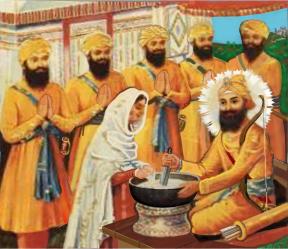 The Panj pyare with Guru Gobind Singh The Panj pyare with Guru Gobind Singh
|
Guru Gobind Singh put pure water into an iron vessel or Bowl (Batta of Sarbloh) and stirred it with a Khanda (two edged small sword). While stirring the water with Khanda, he recited Gurbani (Five Banis- Japji, Jaap Sahib, Anand Sahib, Swayas, and Chaupai). Sugar crystals called ‘Patasas’ which incidently the Guru’s wife, Mata Sahib Kaur, had brought at that moment, were mixed in the water.
Guru Gobind Singh then stood up with the sacred Amrit (nectar) prepared in the iron bowl. Each of the five faithful, by turn, each kneeling upon his left knee, looked up to the Master to receive the divine amrit. He gave five palmfuls of Amrit to each of them to drink and sprinkled it five times in the eyes, asking them to repeat aloud with each sprinkle, “Waheguru Ji ka Khalsa, Waheguru Ji Ki Fateh.” (This means: Khalsa belongs to God and all triumph be to His Name) Then he anointed with five sprinkles in the hair. In this way Amrit was administered to the five faithful from the same bowl. After that he asked them to sip Amrit from the same bowl to signify their initiation into the casteless fraternity of the Khalsa. All the five faithful were baptized in this way by the Guru who then called them the ‘PANJ PYARE’ or Five Beloved Ones.
Guru Gobind Singh gave them the appellation of SINGHS (Lions) and they were named from Daya Ram to Daya Singh, Dharam Das to Dharam Singh, Mohkam Chand to Mohkam Singh, Himmat Chand to Himmat Singh, and Sahib Chand to Sahib Singh. The Guru then addressed them as the supreme, the liberated ones, pure ones and he called them THE KHALSA.
He then ordained them to do the following:
I.First they must wear the following articles whose names begin with ‘K’:
1. Kesh – unshorn hair. This represents the natural appearance of sainthood. This is the first token of Sikh faith.
2. Kanga – A comb to clean the hair.
3. Kachha – An underwear to indicate virtuous character.
4. Kara – An Iron bracelet on the wrist, a symbol of dedication to the Divine Bridegroom.
5. Kirpan – A sword symbolising dignity, power and unconquerable spirit.
II. They must observe the following guidelines:
1. Not to remove hair from the body.
2. Not to use Tobacco or other intoxicants (alcohol).
3. Not to eat or touch Kuttha (Halal or Kosher) meat of an animal (see Hukamnama by Sri Guru Gobind Singh ji to the Sikhs of Kabul).
4. Not to commit adultery- ‘Parnari ki sej, bhul supne hun na jayo‘ (never enjoy, even in dream, the bed of a woman other than your own wife) (A supplementary ordinance was issued that any one who did not observe any of the four directives, must be re-baptized, pay a fine, and promise not to offend any more; or he must be excommunicated from the Khalsa).
III. They must rise at dawn, bathe, meditate on Gurmantar- ‘Waheguru’, Moolmantar- the preamble of Japji, and recite five banis-Japji, Jap Sahib and Swayas in the morning; Rehras in the evening; and Kirtan Sohela at bed time at night.
IV. They must not worship idols, cemeteries, or cremation grounds, and must believe only in One Immortal God. The Guru further spelled out that they should practice arms, and never show their backs to the foe in the battle field. They should always be ready to help the poor and protect those who sought their protection. They were to consider their previous castes erased, and deem themselves all brothers of one family. Sikhs were to intermarry among themselves.
“The creation of the Khalsa was the greatest work of the Guru. He created a type of superman, a universal man of God, casteless and country less. The Guru regarded himself as the servant of the Khalsa. He said, “To serve them pleases me the most; no other service is so dear to my soul.” The Khalsa was the spearhead of resistance against tyranny.” (Miss Pearl, S. Buck)
Guru Gobind Singh’s Bani:
- Worship the One God who is the Lord of all. Know that his form is one and He is the One light diffused in all.”
- “The Khalsa is my own image. I shall always manifest myself in the Khalsa.
- The Khalsa is my body and soul; The Khalsa is the life of my life.
- The Khalsa is my perfect leader. The Khalsa is my brave friend.
- I say nothing untrue and to this; Guru Nanak, united with God, is my witness.”
- “Why impress false religion on the world? It will be of no service to it.
- Why run about for the sake of wealth? You cannot escape from death.
- Son, Wife, friends, disciples, companions none of those will bear witness for thee.
- Think, O think, you thoughtless fool, you shall have in the end to depart alone.” (Swayya 32)

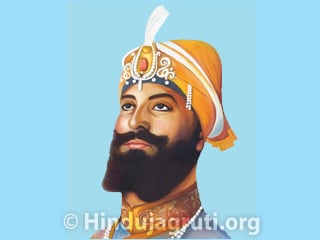
 Swami Vivekananda
Swami Vivekananda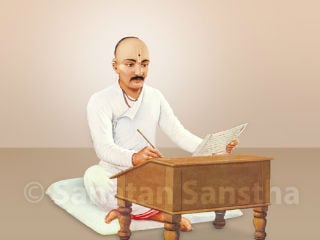 Sant Eknath (1533-1599)
Sant Eknath (1533-1599)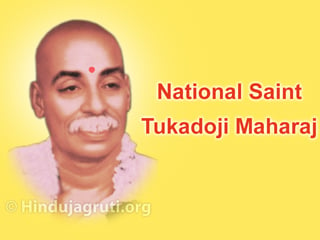 Saint Tukdoji Maharaj
Saint Tukdoji Maharaj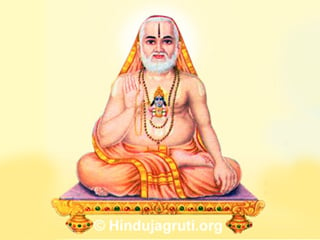 Shri Raghavendra Swami : A Great Devotee of Shri Vishnu
Shri Raghavendra Swami : A Great Devotee of Shri Vishnu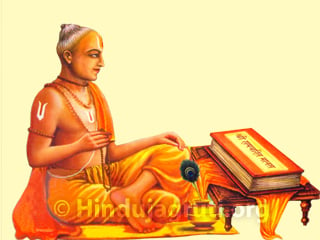 Sant Tulsidas: Great devotee of Deity Ram in Kaliyug
Sant Tulsidas: Great devotee of Deity Ram in Kaliyug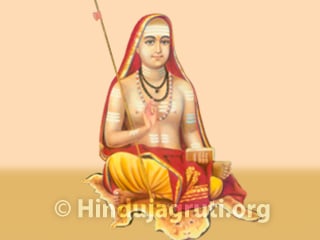 Jagadguru Sri Adi Shankaracharya Jayanti
Jagadguru Sri Adi Shankaracharya Jayanti